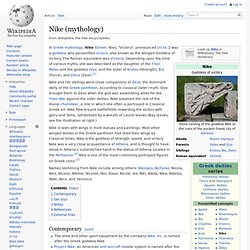

Nike: The Winged Goddess of Victory. This small sculpture of the goddess Nike was carved more than 2,500 years ago.

On top of Nike's head is an egg-shaped container for burning incense. Diamond-shaped holes were cut in the lid to allow the smoke of the burning incense to escape. Ancient Greek artists frequently turned practical objects such as incense burners into beautiful works of art. Ancient Olympics. Nike was the Greek goddess of victory.

She had no clearly identifiable personality, no role in myths, and no cult in a temple of her own. Instead, she was a kind of symbol, an abstraction of 'victory', both military and in sports. She was usually worshipped in combination with another god, e.g. with Zeus at Olympia or with Athena in Athens. As a symbol of victory, Nike is frequently attested in art. She is usually depicted as a winged young woman in a long dress, moving quickly, running or flying. Nike *** Sealstone with the goddess Nike crowning an athlete. Greek, 4th century BC, found at the Temple of Artemis at Ephesos, modern Turkey This small engraved sealstone, perhaps originally from a finger ring, shows the winged goddess Nike placing a crown of leaves on the head of a winning athlete.

In Greek mythology, the goddess Nike was a messenger of the gods and, more generally, the personification of victory. She was also closely associated with Zeus, god of the Olympic Games, and is often shown in flight, bearing a wreath or a victory ribbon, to crown victorious athletes. Statues of Nike featured prominently at Olympia, the site of the ancient Olympic Games, in connection with both sporting and military victories. The victors wreaths associated with Nike were usually made of foliage that could be dried and kept for a long time to preserve the memory of a victory. Winning athletes were showered with flowers and leaves. Nike, the Greek Goddess of Victory - Fast Facts. The name "Nike" is one of the best-known of the Greek goddesses - yet many people don't even realize Nike was a goddess first, sports brand second.

Here is a brief introduction to the story of Nike, the Greek goddess of victory. Nike's Appearance: A fit young woman with a blade and large wings, unusual among later Greek gods and goddesses, though many of them could take on the forms of birds in the myths. Symbol or Attributes of Nike:Her wings; often depicted with a wreath of victory or a staff; the chariot. Nike's Strengths: A very fast runner, swift flyer, able charioteer. Nike's Weaknesses: Can be capricious (inconsistent) in doling out victory. Nike's Parents: Daughter of Styx, called a nymph but actually the presiding spirit over the major river of the Underworld, and Pallas, a Titan. Nike's Spouse: None. Children: None. Some Major Temple Sites for Nike: She is depicted multiple times at the Acropolis of Athens.
Frequent Misspellings and Alternate Spellings: Niki, Nyke, Nykie, Nice. Encyclopedia Britannica. NIKE : Greek Goddess of Victory. NIKE (or Nicé) was the winged goddess or spirit (daimon) of victory, both in battle and peaceful competition.

When Zeus was gathering allies at the start of the Titan War, Styx brought her four children, Nike (Victory), Zelos (Rivalry), Kratos (Strength) and Bia (Force) into the service of the god. Nike was appointed his charioteer, and all four were appointed as sentinels standing beside the throne of the god. Beyond this Nike never acquired any distinctive mythology of her own. Nike was depicted in ancient Greek vase painting with a variety of attributes including a wreath or sash to crown a victor, an oinochoe and phiale (bowl and cup) for libations, a thymiaterion (incense burner), an altar, and a lyre for the celebration of victory in song. Nike (mythology) Nike and her siblings were close companions of Zeus, the dominant deity of the Greek pantheon.

According to classical (later) myth, Styx brought them to Zeus when the god was assembling allies for the Titan War against the older deities. Nike assumed the role of the divine charioteer, a role in which she often is portrayed in Classical Greek art. Nike flew around battlefields rewarding the victors with glory and fame, symbolized by a wreath of Laurel leaves (Bay leaves, see the illustration at right.) Nike is seen with wings in most statues and paintings. Most other winged deities in the Greek pantheon had shed their wings by Classical times.